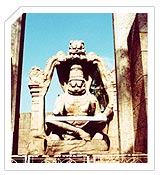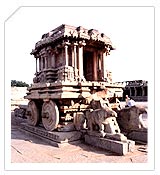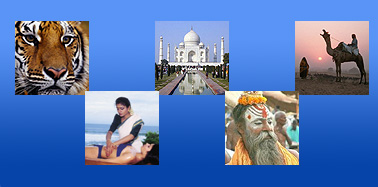|
|
|
|
|
|
|
Home » South
India » Karnatka » Cities » Hampi
|
|
|
|
Back
» Hampi
|
|
|
|
 Hampi, the outstanding land of breathtaking surprises was founded in the middle of 14th Century by two local princes, Hakka & Bukka. The city was sacked pillaged and burnt in 1565 AD, after the combined attack of armies of Muslim Sultanates of the Deccan defeated the Vijayanagar Military Commander and the King fled the Capital. Today, the terrain is dominated by rocky hills and the mighty Tungabhadra River, which flows through this rugged landscape. Hampi, the outstanding land of breathtaking surprises was founded in the middle of 14th Century by two local princes, Hakka & Bukka. The city was sacked pillaged and burnt in 1565 AD, after the combined attack of armies of Muslim Sultanates of the Deccan defeated the Vijayanagar Military Commander and the King fled the Capital. Today, the terrain is dominated by rocky hills and the mighty Tungabhadra River, which flows through this rugged landscape.
One can still take glimpse of the mind-blowing Vijayanagara - one of the largest empires in the history of India - in its ruins. The Vijayanagar Kings were great patrons of Art & Architecture as evident by the vast ruins of Hampi.
Sightseeing at Hampi :
Virupaksha Temple : The Virupaksha Temple at the western end is one of the earliest structures in the city. The main shrine is dedicated to Virupaksha, a form of Lord Vishnu. Overlooking Virupaksha temple to the South, Hemakuta hill has several scattered ruins, which includes Jain temples and a monolithic structure of Narasimha.
Ugra Narasimha : Nearby is the 6.7 m tall monolith of Ugra Narasimha. The massive image is situated in the south of the Hemkuta group of temples that includes the Virupaksha Temple. The Narasimha is a seated four-armed figure under a canopy of a seven-hooded snake.
 Vithala Temple : To the east of Hampi Bazaar is the Vittala temple, about 2 kms away. The ruins of the temple is a World Heritage monument. The temple is relatively well preserved. The temples beautiful sculptures shows the pinnacle of Vijayanagar Art. The outer pillars are known as the 'Musical Pillars' as they reveberate when tapped, although this practice is now discouraged to avoid further damage. The temple also displays an beautifully carved stone chariot in the temple courtyard containing an image of Garuda. Vithala Temple : To the east of Hampi Bazaar is the Vittala temple, about 2 kms away. The ruins of the temple is a World Heritage monument. The temple is relatively well preserved. The temples beautiful sculptures shows the pinnacle of Vijayanagar Art. The outer pillars are known as the 'Musical Pillars' as they reveberate when tapped, although this practice is now discouraged to avoid further damage. The temple also displays an beautifully carved stone chariot in the temple courtyard containing an image of Garuda.
Lotus Mahal : This graceful two-storeyed pavilion is located in the 'zenana' enclosure. The palace is tasteful amalgam of the Hindu and Islamic styles of architecture.
Hazara Rama Temple : The temple built within rectangular complex lies at the heart of the royal centre. The temple dates back to early 15th century. The hall of the Hazara Rama Temple has intricately carved basalt pillars showcasing the incarnations of Shri Vishnu. Around the exterior walls of the hall are three rows of sculptures imaging the main events from the Ramayana.
Queen's bath : The most elaborate of the bathhouses is the 'Queen's bath' situated in the citadel area, south of the Hazara Rama temple. The building is a large square structure, remarkable for the contrast between its plain exterior and the very ornate interior.
Best Season to Visit : September to February.
|
|
|
|
|
| |
|
|
|
|


